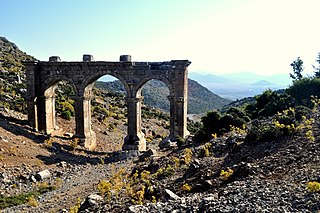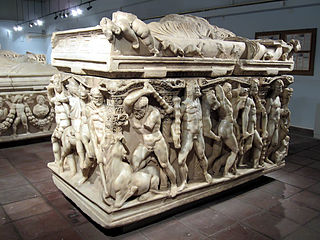Related Research Articles

Ariassus or Ariassos was a town in Pisidia, Asia Minor built on a steep hillside about 50 kilometres inland from Attaleia.
Parlais is a former Roman city of Pisidia.
Bageis, Bagis (Βάγις), or Bage (Βάγη) was an ancient Greek city in the province of Lydia in Asia Minor.
Harpasa was a city and bishopric in ancient Caria in Roman Asia Minor, which only remains a Latin Catholic titular see.

Tiberiopolis was a town in the Roman province of Phrygia Pacatiana, mentioned by Ptolemy, Socrates of Constantinople and Hierocles. At various times, it was considered as part of Phrygia, Isauria, and the late Roman province of Pisidia.
Cotenna or Kotenna was a city in the Roman province of Pamphylia I in Asia Minor. It corresponds to modern Gödene, near Konya, Turkey.
Dalisandus or Dalisandos was a city of ancient Cappadocia and later of Isauria, near the river Cydnus. It is considered to have been near Sınabiç, 6 km north of Claudiopolis, Turkey.
Acalissus or Akalissos was a town of ancient Lycia, an early bishopric, and remains a titular see of the Roman Catholic Church. Coins were minted at Acalissus, some of which are housed at numismatic collections.
Arneae or Arneai was a small city of ancient Lycia mentioned by Capito in his Isaurica. It is located near Ernes, in the interior of Lycia where archaeological remains have been found.
Choma was a place in the interior of ancient Lycia, according to Pliny on a river Aedesa. Ptolemy places Choma as one of the four cities of the Milyas, and places it near Candyba. The town can be identified with a site near today's village of Hacımusalar in the district of Elmalı.
Mastaura was a town in ancient Lycia and is not to be confused with Mastaura (Caria).

Nisa, also Nyssa (Νύσσα) or Nysa (Νύσα) or Neisa (Νείσα), was a town in ancient Lycia near the source of the River Xanthus.
Comama was a town in the late Roman province of Pamphylia Secunda. It has been called Pisidian, not as being in `Pisidia, but as founded on what was the Pisidian frontier of the Roman Empire.
Dalisandus or Dalisandos was an ancient city and bishopric in eastern Pamphylia, in Asia Minor and remains a Latin titular see.

Parnassus or Parnassos was a town in the northern part of ancient Cappadocia, on the right bank of the Halys River, and on or near a hill, to which it owed its name, on the road between Ancyra and Archelais, about 63 miles west of the latter town. It became a bishopric and remains a Roman Catholic titular see.
Coela was a Roman city and bishopric in the province of Europa and is now a Latin Catholic titular see.

Justinianopolis in Armenia also known as Iustinianopolis was a Roman and Byzantine era city and bishopric in Lesser Armenia. It has been identified with modern Sivrihisar, Eskişehir Province Central Anatolia, Turkey. It was one of several ancient sites renamed in late Antiquity after Byzantine emperor Justinian I. The city also known as Acilisene and Keltzene.
Zarela, also known as Durzela, Zorzila, Dyrzela, and Zorzela, was a city and bishopric in ancient Pisidia, which remains a Latin Catholic titular see. It site is unlocated.
The Stauropolis is the former metropolitan see of Caria in Asia Minor within the Patriarchate of Constantinople. It remains a titular see of the Roman Catholic Church.
References
- 1 2 Richard Talbert, ed. (2000). Barrington Atlas of the Greek and Roman World . Princeton University Press. p. 65, and directory notes accompanying.
- ↑ Lund University. Digital Atlas of the Roman Empire.
- ↑ Heinrich Gelzer, Ungedruckte und ungenügend veröffentlichte Texte der Notitiae episcopatuum, in: Abhandlungen der philosophisch-historische classe der bayerische Akademie der Wissenschaften, 1901, p. 556, nº 452.
- ↑ Annuario Pontificio 2013 (Libreria Editrice Vaticana 2013 ISBN 978-88-209-9070-1), p. 850
- ↑ a) Eintrag on catholic-hierarchy.org
b) (in German) Apostolische Nachfolge - Titularsitze
c) Entry on GCatholic.com